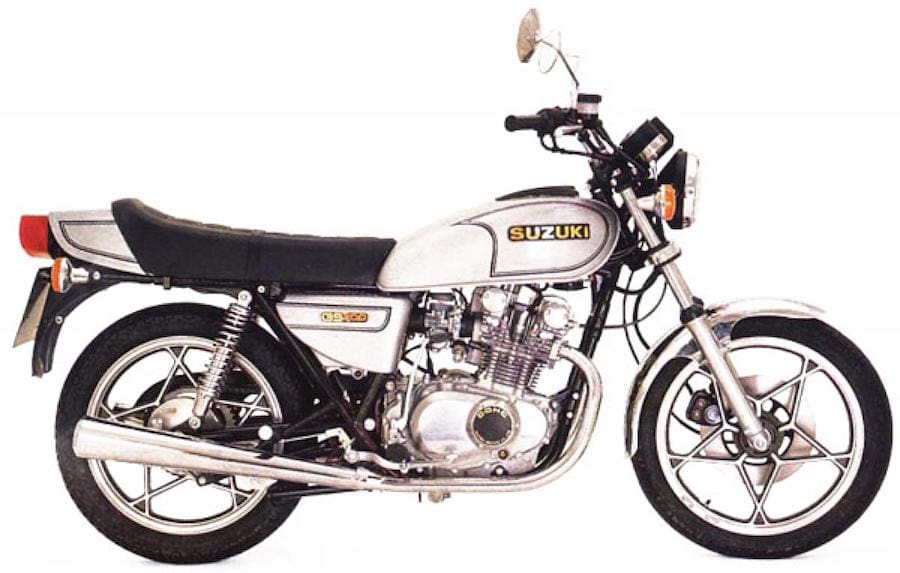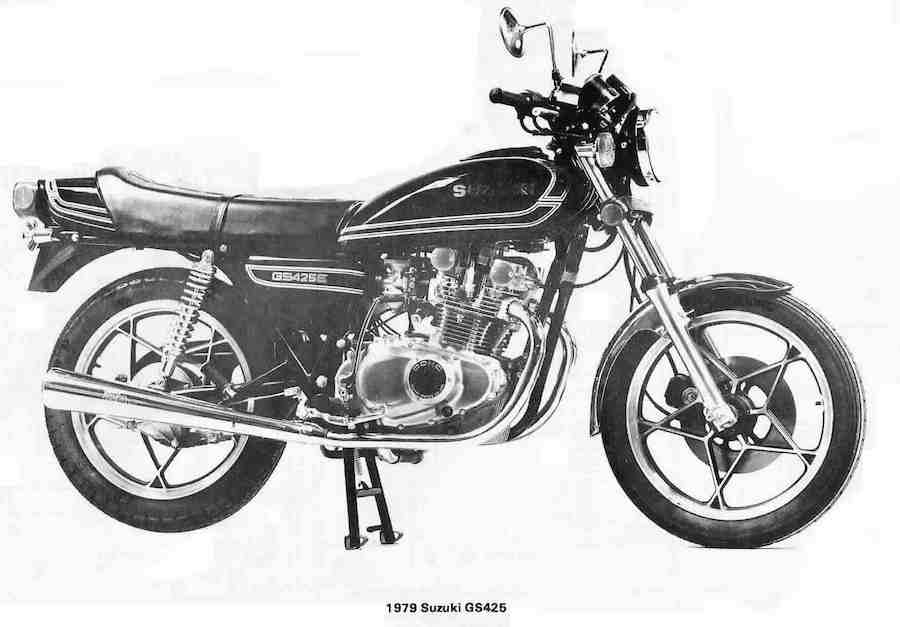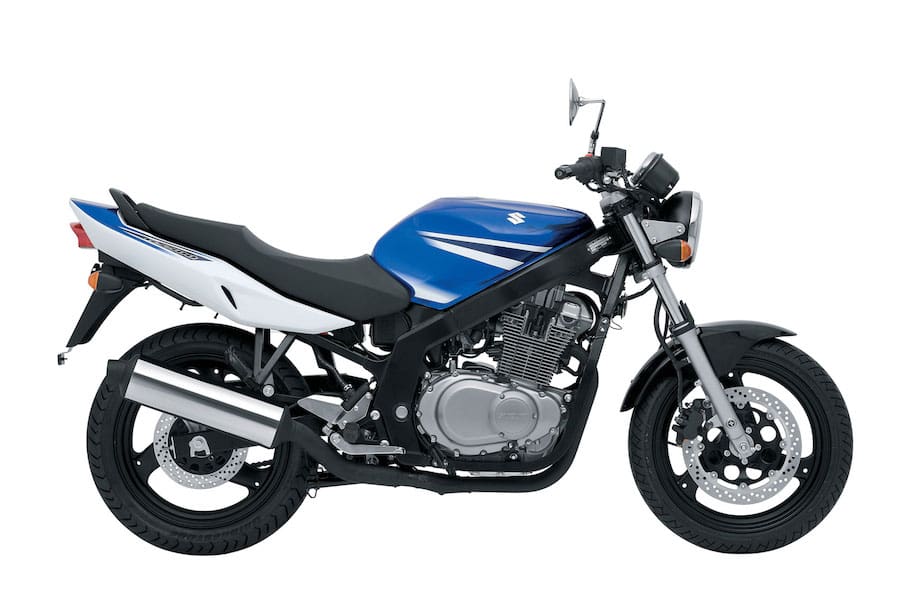The stunning 19-year model run of Ford’s pioneering Model T was a reward for its affordability, simplicity, ruggedness and all-round competence. Which brings us to the Suzuki GS500 that emphatically ticked the same set of boxes as the trusty old Ford, and trumped it with a 25-year model life.
The Suzuki GS500 was a different creature from the much-praised GS450 it replaced in 1989.
While the modest boost to engine capacity was welcome, it was the comprehensive chassis revamp that changed the bike fundamentally, improving handling and braking and giving the new Suzuki twin distinctive styling and a sporty stance. The new twin-spar steel perimeter-frame was more modern and stiffer than the 450’s old-school tubular-steel version.
A monoshock with rising-rate linkage replaced the 450’s dated twin-shock set-up and a sturdy 37mm fork replaced the spindly 33mm unit. Braking also took a major step up, with a rear disc for the first time and a big 310mm front floater with a twin-piston caliper.
The GS500’s hard-to-kill air-cooled parallel-twin features a 180-degree crankshaft, chain-driven twin cams and two valves per cylinder. Twin Mikuni carbs handle fuelling. While cold-morning starts call for a couple of minutes on the choke, the trusty twin is soon hot to trot. Clutch action is light and the gearbox is a slick-shifting six-speeder.
For a middleweight, the GS has surprisingly accommodating ergonomics for riders and passengers, ranging from the small to the quite tall. Seat comfort is great for commuting and reasonable for touring.
Instruments are basic but effective twin analogue dials.
While finish isn’t quite on a par with upmarket Suzukis, and the mild steel exhaust is subject to surface corrosion, the GS500 is way more than a cheap and cheerful motorcycle.
It’s very rider-friendly thanks to a low 790mm seat height and a modest 174kg (dry) weight. The engine’s 38kW max power, strong midrange torque and appetite for revs make for a reasonably lively ride on what is after all a LAMS bike.
Couple linear throttle response with easy manoeuvrability in traffic, then throw in a modest fuel thirst and legendary reliability, and you can see why the GS was a favourite of courier riders both here and in the UK.
Acceleration from the lights on a GS shames most tin-tops. Highway cruising ability at 140km/h, even two-up with luggage, is tireless, with a top-whack, solo, of close to 190km/h (remember those days?).
While the front-end is a bit soft (pre-load is adjustable from 1992 on), overall handling is excellent. Agile and responsive in heavy traffic, its quickish steering and serious lean angles make it a barrel of fun out in the hills. The single front disc is excellent, outperforming the twin discs of some contemporaries from the early 90s. And a GS won’t frighten you if you decide to explore gravel roads.
The 17-litre tanks of pre-2001 models give a safe touring range of 320km-plus while newer 20-litre models up that to at least 380km.
This bike built its reputation in its naked form, variously known as the GS500E and GS500 over the years (some mid-90s models sported a tiny headlight fairing). From 2004 the GS500 was joined in the showroom by the faired GS500F version.
Whether you’re a newcomer to bikes or a lapsed rider wanting to get back in the saddle with minimal investment, you’d be letting yourself down if you didn’t include the trusty GS500 on your shortlist.
In terms of its engineering quality, reliability and miserly costs to own and operate, its record speaks for itself. While the GS twin is somewhat missing in action in the street-cred stakes, it’s actually fun to ride, giving its rider entrée into the vast majority of road-riding’s pleasures.
Building Bricks
Here are the bikes that mark the evolution of the Suzuki GS500
1976– Suzuki GS400
The release of Suzuki’s GS400 twins and GS750 fours signalled the Hamamatsu brand’s first move into four-stroke territory. The market was impressed.

1979 – Suzuki GS425
An increase in displacement of 23mm saw Suzuki’s middleweight twin boost its growing reputation as an impressive performer.

1980 – Suzuki GS450
The revised engine incorporated changes that included a new plain-bearing bottom end. This same engine with a 3mm bore increase would power the GS500.

WHAT TO LOOK FOR
The Suzuki GS500 is a simple, rugged, trouble-free bike. Well-maintained examples seem to clock up around 70,000km before even needing a cam-chain – impressive for a high-revving, hard-working, air-cooled twin.
Although noisy during warm-up, a good one should be mechanically quiet at operating temperature. Look for regulator/rectifier issues and oil leaks from the cylinder-head gasket.
Always factor into your buying decision the cost of any steering-head bearings, chain, sprockets, brake pads and brake rotors that will soon need replacing.
A low-kays example with service records is ideal.

SERVICE HISTORY
The Suzuki GS500 is an easy bike to work on. Major components are easily accessible, though less so on faired models.
The basic service at 6000km intervals for oil and filter changes also involves re-torqueing the head bolts and checking valve clearances. Its shim-adjusted set-up is one of the simpler versions you’ll encounter. Carrying out this work and getting to know its carburettors offers DIY GS owners the chance to build their maintenance skills on what is a mechanic-friendly bike. Sparkplug replacement comes at 12,000km intervals.
Price Guide
New Price
$4999 (1989) – GS500E
$5990 (2014) – GS500
Second-Hand
$1600-5200 –
GS500E/500











